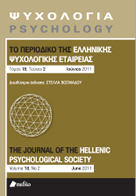Η κατανόηση της πυκνής διάταξης των ρητών από μαθητές Β΄ Λυκείου: ένα διδακτικό πείραμα

Περίληψη
Η μετάβαση από τους φυσικούς στους ρητούς αριθμούς παρουσιάζει δυσκολίες για τους μαθητές, μέρος των οποίων οφείλεται στην καταχρηστική μεταφορά γνώσης για τους φυσικούς στους ρητούς. Μια ιδιότητα των φυσικών αριθμών που μεταφέρεται καταχρηστικά στους ρητούς είναι η διακριτότητα: Αντίθετα με το σύνολο των ρητών αριθμών, το σύνολο των φυσικών αριθμών είναι διακριτά διατεταγμένο, δηλαδή, για κάθε φυσικό αριθμό ορίζεται ο επόμενός του. Οι ρητοί αριθμοί είναι πυκνά διατεταγμένοι, δηλαδή, δεν ορίζεται ο επόμενος για κανέναν αριθμό στο σύνολο αυτό. Η προσέγγιση της θεωρίας πλαισίου στην εννοιολογική αλλαγή προβλέπει ότι οι θεμελιώδεις παραδοχές των μαθητών για τον αριθμό ως φυσικό δεν αίρονται δια μιάς, με την ιδέα της διακριτότητας να είναι ιδιαίτερα ανθεκτική. Στην εργασία παρουσιάζεται ένα διδακτικό πείραμα με 15 μαθητές Λυκείου. Εξετάσαμε την υπόθεση ότι διαφορετικές πτυχές της πυκνότητας των ρητών αριθμών (συγκεκριμένα, η απειρία των ρητών σε οποιοδήποτε διάστημα και η μη ύπαρξη του επόμενου), παρότι μαθηματικά ισοδύναμες, παρουσιάζουν διαφορετικές δυσκολίες για τους μαθητές. Η αρχική κατανόηση των μαθητών για την πυκνότητα ελέγχθηκε ατομικά. Κάθε μαθητής ξεχωριστά συμμετείχε σε μικρής διάρκειας παρέμβαση, στην οποία εισήχθη η ιδέα του αριθμητικού μέσου ενός διαστήματος ως εργαλείο που δυνητικά μπορεί να οδηγήσει στην κατανόηση και των δύο πτυχών της πυκνής διάταξης. Τέλος, κάθε μαθητής επανεξέτασε τις απαντήσεις του στα έργα του προελέγχου και παρακινήθηκε να αξιοποιήσει την ιδέα του αριθμητικού μέσου. Τα αποτελέσματα δείχνουν ότι οι μαθητές συνέχισαν να θεωρούν ότι υπάρχει ο επόμενος στους ρητούς, ακόμα και όταν συμπέραναν την απειρία των ενδιάμεσων. Υπό το πρίσμα της θεωρίας που υιοθετήσαμε, η αντίληψη αυτή είναι συνθετική, καθώς οι μαθητές αλλάζουν μερικώς την αντίληψή τους για τη διάταξη των ρητών, χωρίς να αίρεται η αρχή του επόμενου αριθμού.
Λεπτομέρειες άρθρου
- Πώς να δημιουργήσετε Αναφορές
-
Φωκάς Δ., & Βαμβακούση Ξ. (2022). Η κατανόηση της πυκνής διάταξης των ρητών από μαθητές Β΄ Λυκείου: ένα διδακτικό πείραμα. Ψυχολογία: το περιοδικό της Ελληνικής Ψυχολογικής Εταιρείας, 27(1), 48–65. https://doi.org/10.12681/psyhps.30686
- Ενότητα
- ΕΙΔΙΚΟ ΑΦΙΕΡΩΜΑ

Αυτή η εργασία είναι αδειοδοτημένη υπό το Creative Commons Attribution-ShareAlike 4.0 International License.
Το περιοδικό ΨΥΧΟΛΟΓΙΑ έχει υιοθετήσει μία πολιτική Platinum open-access. Τα έξοδα υποβολής, επεξεργασίας ή δημοσίευσης των εργασιών καλύπτονται από την Ελληνική Ψυχολογική Εταιρεία. Τα πνευματικά δικαιώματα των δημοσιευμένων εργασιών προστατεύονται από την άδεια 'Creative Commons Attribution-ShareAlike 4.0 International'. Οι Συγγραφείς διατηρούν τα Πνευματικά Δικαιώματα και χορηγούν στο περιοδικό το δικαίωμα της πρώτης δημοσίευσης. Η άδεια αυτή επιτρέπει σε τρίτους, να χρησιμοποιούν την εργασία σε οποιαδήποτε μορφή, με την προϋπόθεση της διατήρησης των διατυπώσεων που προβλέπονται στην άδεια σχετικά με την αναφορά στον αρχικό δημιουργό και την αρχική δημοσίευση στο περιοδικό ΨΥΧΟΛΟΓΙΑ. Επιπλέον, κάθε διανομή της εργασίας οφείλει να γίνεται με τους ίδιους όρους διανομής, δηλαδή με την ίδια άδεια Creative Commons.



